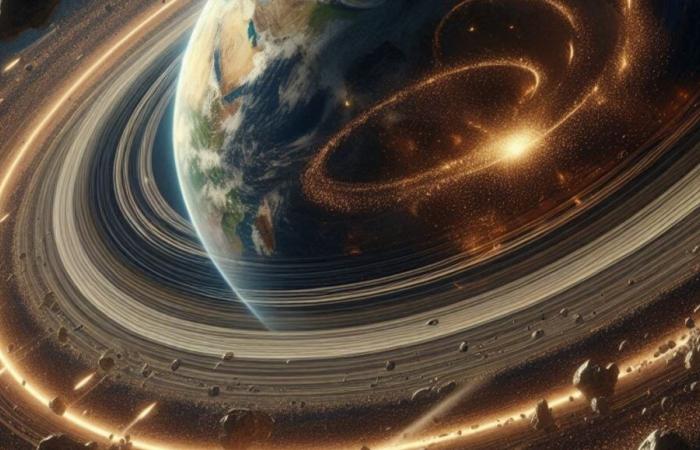Saturn’s rings are majestic. Astronomers never cease to admire them and wonder what the Earth would look like with such a system around it. Illustrator Ron Miller had also created striking montages of our planet thus adorned.
Photomontage of the Earth with rings.
© Ron Miller
Advertisement, your content continues below
The rings seen from the equator, in Guatemala.
© Ron Miller
The history of our planet and the life that developed on it is closely linked to space conditions, as well as to events in the solar system. Dinosaurs learned this the hard way 66 million years ago, and various major extinctions are linked in whole or in part to giant impacts.
It is by noting the arrangement of 21 impact craters that an Australian team led by Andrew G. Tomkins proposes not only a link with cataclysms that occurred during the Ordovician, a little less than 500 million years ago when life was essentially marine (tsunamis, earthquakes, ice age, etc.). The researchers even estimate that biodiversity during this era, of which we are distant fruits, was favored by what they discovered.
These 21 craters were all close to the equator 466 million years ago!
Tectonic plates are slowly but constantly changing the surface of our planet, and geologists know how to model these changes in our rocks. Here’s what Earth looked like 466 million years ago — and the video from which it’s captured.
Advertisement, your content continues below
Position of tectonic plates 466 million years ago.
© Merdith, AS, Williams, SE, Collins, AS, Tetley, MG, Mulder, JA, Blades, ML, Young, A., Armistead, SE, Cannon, J., Zahirovic, S. and Müller, RD, 2020. Earth-Science Reviews, p.103477
Where the investigation becomes exciting is that it has long been known that a layer of iron-poor meteoritic dust (chondrite L) enriched the Earth’s soil over a fairly short period of time.
The 21 craters with their diameter and period of formation.
© Andrew G. Tomkins et al (sciencedirect)
Here is the scenario proposed by the team of researchers:
An L-type asteroid approaches Earth and enters its Roche lobe, where the gravitational intensity is too strong and breaks it into fragments. These then orbit around the equator because of the centrifugal effect, where they form rings visible from the ground and capable of masking the light of the Sun. The largest ones will then hit our surface, leaving the craters and the clues noted by the researchers. Therefore, the probability that these impacts have this equatorial arrangement without a common cause linking them is negligible.
Such events do occur occasionally, notably when the comet Schoemaker Levy 9 exploded before colliding with Jupiter in 1994. We can also observe such impacts on the surface of the Moon, as in the crater Clavius where a curved chain of craters leaves little room for doubt as to its origin.
Composite photo of fragments of comet Schoemaker Levy 9 just before their impacts in Jupiter’s atmosphere (May 1994)
© Nasa, Esa, H. Weaver and E. Smith (STScI) & J. Trauger & R. Evans (Nasa’s Jet Propulsion Laboratory)
Clavius crater with its curved chain of internal craters, from largest to smallest, caused by a fall of fragments of a probable same origin.
© Shaihulud DD (CC)
By 466 million years ago, the Earth probably had its own rings, dense enough to block out the Sun’s light and cause the Ordovician glaciation. Losing speed, the fragments then fell to Earth, leaving craters that, as tectonic movements spread out.
Advertisement, your content continues below






